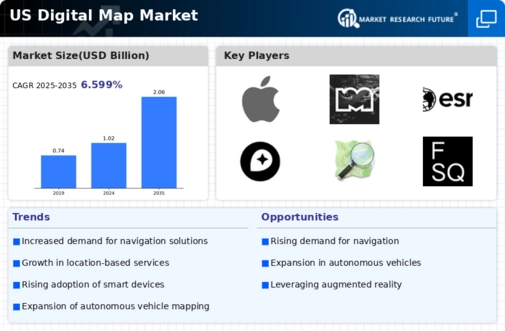The US Digital Map Market is rapidly evolving, driven by innovations in technology, consumer needs, and a growing demand for real-time information and navigation. Numerous players inhabit this landscape, competing fiercely to leverage new opportunities created by advances in artificial intelligence, data analytics, and cloud computing. This market is characterized by a blend of established tech giants and nimble startups, each vying for a foothold in various applications, including navigation for vehicles, mobile devices, and even smart city planning. Additionally, geographical information systems (GIS) play a crucial role in enhancing the precision and versatility of digital mapping services.
The competitive dynamics are intensified by the need for continuous improvements in usability, data accuracy, and integration with other digital services, creating a vibrant ecosystem rife with competition and innovation.
Apple has firmly established itself as a significant player in the US Digital Map Market, significantly impacting how users interact with digital mapping services on mobile devices. Utilizing its extensive ecosystem, Apple leverages advanced features such as real-time traffic updates and integration with other Apple services to enhance the user experience. The company's strength lies in its focus on data privacy, ensuring that user information is safeguarded while delivering customized and location-based services.
Furthermore, Apple has invested heavily in mapping technologies and partnerships to improve its offerings continually, expanding its coverage and accuracy while establishing a unique selling proposition that resonates well with its customer base. With a growing emphasis on user-centric design and the seamless integration of mapping services into its broader suite of applications, Apple effectively maintains a competitive edge in the market.MapQuest has carved out its niche within the US Digital Map Market by focusing on practical solutions that cater specifically to navigation and location-based services.
Known for its user-friendly interface and reliable mapping functionalities, MapQuest remains a familiar name for many consumers, particularly for routing and turn-by-turn navigation.
The company offers various services, including live traffic updates, route optimization, and point-of-interest searches, which enhance the overall user experience. MapQuest has also engaged in strategic partnerships to bolster its functionalities and provide value-added services. While it may face intense competition from more prominent players in the digital mapping arena, its emphasis on continuous improvement and adaptation to the latest technological developments allows it to maintain a solid market presence. Mergers and acquisitions in the space have further enabled MapQuest to enhance its mapping data, boosting its capabilities and strengthening its position within the competitive landscape of the US market.























